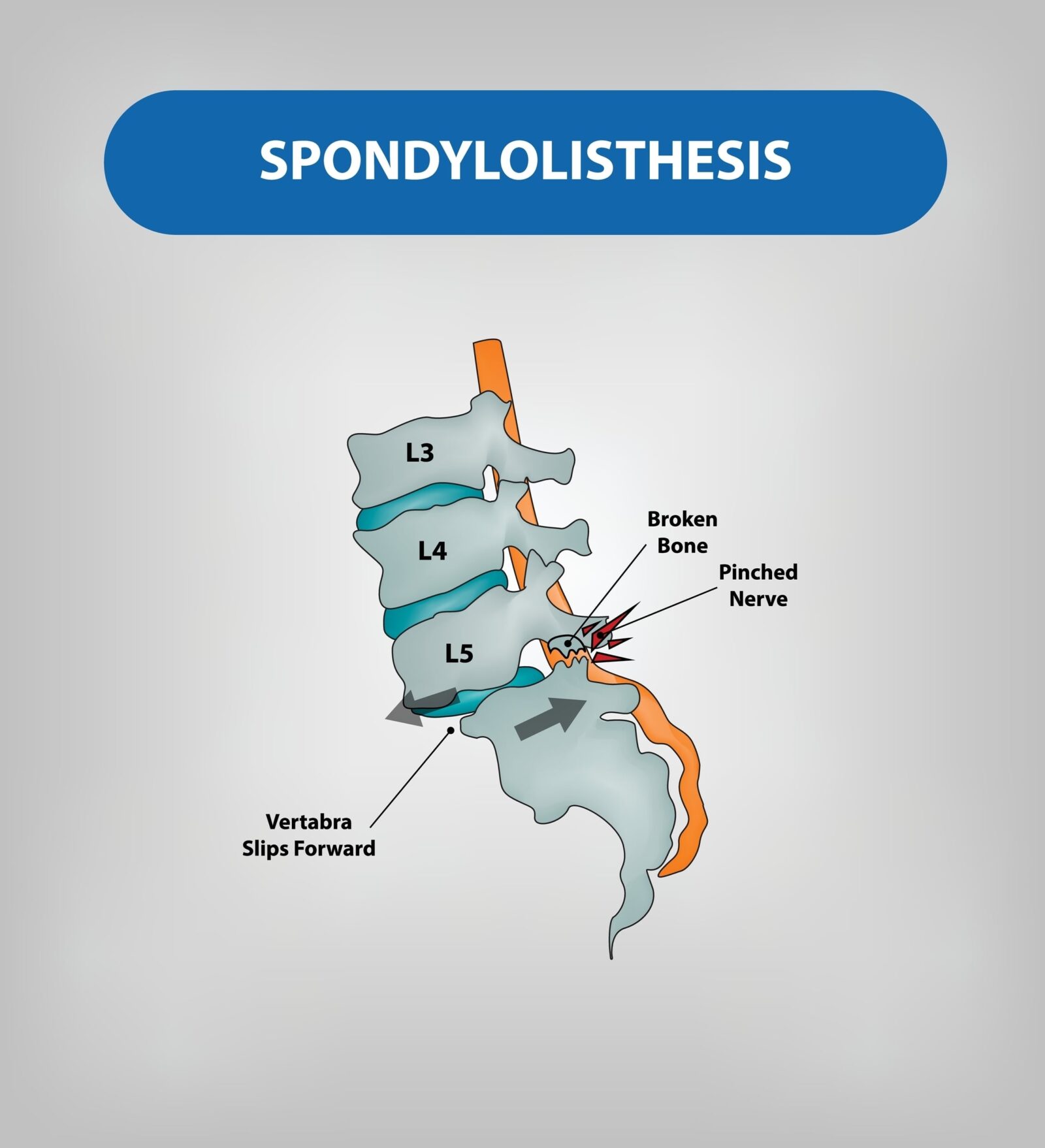Spondylolisthesis, a term that might seem daunting at first glance, is a condition that affects many people around the world. It refers to the forward displacement of a vertebral body in relation to the one beneath it. This condition can manifest in various forms, with each type having its unique causes and characteristics. In this blog, we will focus on three primary types of spondylolisthesis: Congenital, Isthmic, and Degenerative. Let’s dive in and understand the distinctions between them.
Congenital Spondylolisthesis
Congenital spondylolisthesis, also known as dysplastic spondylolisthesis, is a type that is present from birth. It arises due to an abnormal formation or malformation of the vertebrae, leading to their misalignment.
Causes:
- Genetic Factors: Some individuals may inherit a predisposition to vertebral malformations.
- Abnormal Vertebral Development: During fetal growth, the vertebrae may not form correctly, leading to structural weaknesses that can result in spondylolisthesis.
Symptoms:
- The condition may be asymptomatic in many individuals, meaning they experience no symptoms.
- Some affected individuals may experience lower back pain, especially after prolonged activity.
- There may be tightness or stiffness in the hamstring muscles.
- In severe cases, nerve compression can occur, leading to symptoms like numbness, tingling, or weakness in the legs.
Diagnosis:
Congenital spondylolisthesis is often diagnosed through imaging studies like X-rays, which can reveal the misalignment of the vertebrae. MRI or CT scans might also be used to assess the extent of the condition and any impact on the spinal nerves.
Treatment:
The treatment approach depends on the severity of the condition and the presence of symptoms:
- Conservative Treatment: For mild cases or those without significant symptoms, physical therapy, pain management, and bracing might be recommended.
- Surgical Intervention: In cases where there’s significant vertebral slippage, neurological symptoms, or if conservative treatments are ineffective, surgery might be necessary to realign the vertebrae and stabilize the spine.
Isthmic Spondylolisthesis
Isthmic spondylolisthesis occurs due to a defect or fracture in a part of the vertebra called the pars interarticularis. This defect can either be a stress fracture or an elongation without a clear fracture.
Causes:
- Pars Defect: The primary cause is a defect or fracture in the pars interarticularis, which can be due to:
- Stress Fracture: Often resulting from repetitive trauma or overuse, especially in activities that require hyperextension of the spine.
- Elongation without Clear Fracture: Sometimes, the pars interarticularis can elongate without an evident fracture, leading to spondylolisthesis.

Symptoms:
- Lower Back Pain: This is the most common symptom and can be chronic in nature.
- Hamstring Tightness: Affected individuals may experience stiffness or tightness in the hamstring muscles.
- Postural Changes: There might be noticeable changes in the posture, especially in the lumbar region.
- Neurological Symptoms: In cases where the slippage is significant, it can lead to nerve compression, causing symptoms like numbness, tingling, or weakness in the legs.
Diagnosis:
- X-rays: This is the primary diagnostic tool, where lateral views can clearly show the slippage of the vertebrae.
- MRI or CT Scans: These might be used to assess the degree of nerve compression and the condition of intervertebral discs.
Treatment:
The treatment approach is determined by the severity of the slippage and the presence and intensity of symptoms:
- Conservative Treatment: This includes physical therapy, pain management, and possibly bracing. Physical therapy often focuses on strengthening the core muscles to provide better support to the spine.
- Surgical Intervention: Surgery might be considered in cases where:
- There’s significant vertebral slippage.
- Conservative treatments fail to alleviate symptoms.
- There are pronounced neurological symptoms due to nerve compression.
Degenerative Spondylolisthesis
Degenerative spondylolisthesis occurs when one vertebral body slips forward over the one beneath it as a result of degenerative changes in the spine’s joints and discs. Unlike other types of spondylolisthesis, degenerative spondylolisthesis is not associated with a defect or fracture in the pars interarticularis.
Causes:
- Aging Process: As individuals age, the intervertebral discs lose hydration and elasticity, leading to decreased disc height.
- Arthritic Changes: Osteoarthritis can affect the facet joints in the spine, causing them to weaken and allow vertebral slippage.
- Ligament Laxity: Over time, the ligaments of the spine can become less taut, contributing to vertebral misalignment.
Symptoms:
- Lower Back Pain: This pain can be exacerbated by standing or walking and might be relieved when sitting or bending forward.
- Leg Pain: Pain can radiate to the buttocks or legs, especially if there’s nerve compression.
- Numbness or Tingling: These sensations can be felt in the legs if the spinal nerves are compressed.
- Stiffness: The lumbar region might feel stiff, especially after waking up or after prolonged periods of inactivity.
Diagnosis:
- X-rays: These can reveal the slippage of the vertebrae and other degenerative changes in the spine.
- MRI: This imaging study can provide detailed images of the soft tissues, including the intervertebral discs and spinal nerves, helping to identify nerve compression.
Treatment:
The treatment approach is based on the severity of symptoms and the degree of vertebral slippage:
- Conservative Treatment: Initial treatments often include physical therapy, non-steroidal anti-inflammatory drugs (NSAIDs), and lifestyle modifications such as weight management and posture correction.
- Epidural Injections: These can be used to alleviate pain and inflammation, especially if there’s nerve involvement.
- Surgical Intervention: Surgery might be recommended if:
- Conservative treatments are ineffective.
- There’s significant nerve compression leading to neurological symptoms.
- The vertebral slippage continues to progress.
Common surgical procedures include spinal fusion, where the affected vertebrae are fused together to prevent further slippage, and decompression, where portions of the vertebrae or disc material are removed to relieve pressure on the spinal nerves.
In Conclusion
Spondylolisthesis is a multifaceted condition with various types, each with its distinct causes and implications. Recognizing the differences between congenital, isthmic, and degenerative spondylolisthesis is crucial for accurate diagnosis and effective treatment. If you suspect you have spondylolisthesis or experience persistent back pain, seek medical advice. Early intervention can prevent complications and enhance the quality of life.










